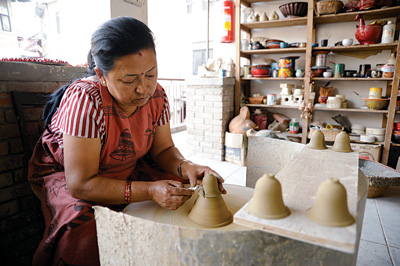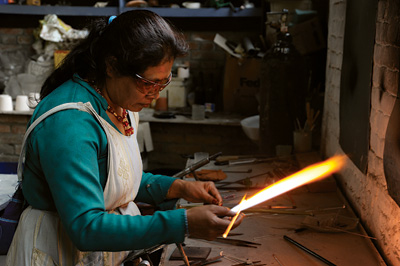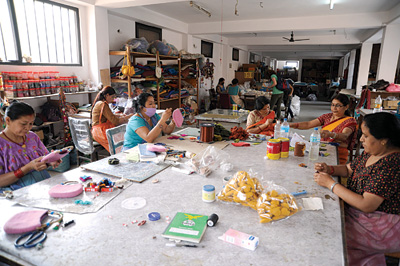Recently dyed blue felt lies in the sun in the courtyard to dry, one lady cards wool by hand, another soaps a felt purse to set its shape. Fine art graduates sit at their computers working on new designs, women sit knitting and gossiping. On the ground floor, teams oversee the washing of the cotton on enormous machines, a woman sporting protective goggles fires some glass. Upstairs ladies in aprons are block and screen printing linen. One lady sits in silence as she cuts a delicate line into the clay mould of a bell. The courtyard seems deserted but in the rooms surrounding, people are working steadily. Walking round the resource centre of the Association for Craft Producers, it is inspiring to imagine all the effort and dedication that has lead up to this point.
 Fair Trade Group Nepal
Fair Trade Group Nepal
The Association for Craft Producers is the founder chair of The Fair Trade Group Nepal, a group which, among other things, provides a platform for group members to discuss issues and share ideas and knowledge concerning fairly traded handicrafts.
At the time of the establishment of ACP in the early eighties, ‘Fair Trade’ was not a familiar term. During the eighties numerous development oriented craft based organisations came into existence, many promoting fair trade practices in Nepal. By the nineties, although there was noticeable improvement in the work these organisations were administering, Nepal was still emerging from its years of political isolation. There was no common platform to deal with the various issues organisations were facing at a national level.
In order to combat the personal and political isolation she was facing regarding trading fairly in handicrafts, Executive Director of ACP, Meera Bhattarai joined The Pressure Group of Nepal. Unfortunately she discovered that the group addressed a rather more broad aspect of women’s life, issues such as property rights, gender equality, legal rights, abortion rights and girl trafficking. Issues which were well and good but what Bhattarai was concerned with was the crux of the problem of Nepal; economic independence. Bhattarai needed concrete information such as how to resource raw material and how to organise a disintegrated workforce. Disappointed with the pressure group, she shared her concerns with an Oxfam representative. As a result in 1993, upon the invitation of the Oxfam representative a diverse group of people from different organisations gathered together.
Over the course of the next three years seven organisations discussed their mutual concerns and dilemmas. By 1996 when a certain level of understanding was established among them, the seven organisations formalised the NGO, The Fair Trade Group Nepal (FTGN) under the chairmanship of ACP. Presently there are seventeen members of FTGN. The group is now well known for its solidarity and members include Mahaguti, Maiti Nepal and Janakpur Women’s Development Corporation. With the inception of FTG Nepal various activities have been conducted to generate awareness about Fair Trade amongst people. These include fair trade rallies, conferences and workshops, joint exhibitions and fair trade fashion shows. With the impact of fair trade, big business houses have started to promote social and corporate responsibility.
 FTGN have been able to prove that the Fair Trade stamp does not necessarily translate as small scale. Trading in handicrafts can be large scale and sustainable, providing quality products to customers and a fair income to producers. For the FTGN member organisations, though commercial success is important, it is the commitment to the welfare of poor, disadvantaged groups that is the overriding goal of their activities. FTG Nepal aims to raise the socio-economic status of underprivileged and marginalised producers and influence policy makers to be Fair Trade friendly. “I would like to see courses in Fair Trade in Nepal, they don’t have vocational qualifications in our schools. Young people should take Fair Trade further,” advocates Meera Bhattarai.
FTGN have been able to prove that the Fair Trade stamp does not necessarily translate as small scale. Trading in handicrafts can be large scale and sustainable, providing quality products to customers and a fair income to producers. For the FTGN member organisations, though commercial success is important, it is the commitment to the welfare of poor, disadvantaged groups that is the overriding goal of their activities. FTG Nepal aims to raise the socio-economic status of underprivileged and marginalised producers and influence policy makers to be Fair Trade friendly. “I would like to see courses in Fair Trade in Nepal, they don’t have vocational qualifications in our schools. Young people should take Fair Trade further,” advocates Meera Bhattarai.
 The Association for Craft Producers
The Association for Craft Producers
ACP was established in 1984, its two priorities being, income generation and empowerment for women through handicrafts, and the preservation of traditional culture and crafts which are either dormant or at the point of disappearing entirely. At first, ACP’s start up costs were covered by donors. Keen to function as a business however, towards the commencement of their forth year in 1987 it was a fully self sustained, and profiting enterprise.
Leather at ACP is produced by Sarkis (traditional caste of cobblers) in Sindhupalchowk. Copper comes all the way from Palpa and paper is transported to Kathmandu from Charikot to list but a few sources of raw material. Over the years ACP has grown from an organisation which employed the services of 38 producers to a hefty 1200 producers to date; 1100 home-based and 90 in house. These in house producers are engaged in the preparation of the raw material, the development of the designs and the finishing of the crafts. ACP aims to provide design, marketing, management and technical services for low income, primarily female, craft producers.
ACP’s progress has been impeded by the lack of technical knowhow, unavailability and raw material in th e country and not being able to address the need of technical advancement. Despite this ACP has been able to expand its outreach and improve its service to its target group. One of ACP’s achievements is that they have successfully managed to meet the ever rising cost of living in Nepal. In addition to fair wages, various social benefits are offered to the producers; both the in house and home based. The detailed, producer welfare program includes such benefits as, a paid paternity and maternity leave, a month’s financial bonus for Dashain, clothing allowance, a financial gesture towards the producer’s children’s education and a retirement fund.
e country and not being able to address the need of technical advancement. Despite this ACP has been able to expand its outreach and improve its service to its target group. One of ACP’s achievements is that they have successfully managed to meet the ever rising cost of living in Nepal. In addition to fair wages, various social benefits are offered to the producers; both the in house and home based. The detailed, producer welfare program includes such benefits as, a paid paternity and maternity leave, a month’s financial bonus for Dashain, clothing allowance, a financial gesture towards the producer’s children’s education and a retirement fund.
ACP has succeeded in changing the traditional notion that craft can only be a pass time. It has proven that an organised work force of women with farm and family responsibilities, working irregular hours can be co-ordinated and turned into a fully competent and reliable work force. Trading in traditional Nepali handicrafts, if backed by integrated system is indeed sustainable. Unlike tourism where a bigger portion of the money is spent in the base country on preliminary travel arrangements, hundred percent of the profit from handicraft sales comes straight back into the country.
“You know people talk a lot about the economic value of handicraft. Through what we are doing these women are earning their own money, they are gaining confidence in themselves, they are making their own decisions, they are sending their children to school and buying food to put on the table. This is what we value.” reflected Bhattarai.











